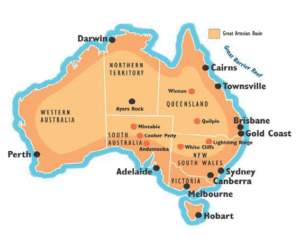FAQ Where are the opal fields in Australia? Where are opals mined? Where is opal mined? Where is opal mining done? When was opal discovered?
Although there are lots of opal mining towns in Australia there are four which have become household names – Coober Pedy, Andamooka, White Cliffs and Lightning Ridge. They are wild and unruly places surrounded by a moonscape of mullock humps where people fight against horrendous climate conditions in their search for precious gemstones. They are, as one observer noted, ‘monuments to the tenacious optimism of all mankind’.

(Opal mines are indicated by an orange dot)
Currently, Australia produces around 95% of the world’s opal for use in the jewellery industry. Other countries in which opal is found in small amounts include Honduras, Mexico, former Czechoslovakia, and Brazil, however these types of opal often differ in appearance. Australian opal is considered the finest in the world.
The Australian export market for opals in 1998-99 was estimated at $60 million compared with $69 million in 1997-98 and $85 million in 1996-97. Between 2000 and 2005, production figures for uncut gems varied between $100 million and $200 million.
Australia’s Opal fields lie in the three states of Queensland, New South Wales, and South Australia, along the site of the ancient ‘Great Inland Sea’, or ‘Great Artesian Basin’. White, or ‘Milky’ opal, is found in South Australia, Black opal is found in Lightning Ridge, NSW, and Boulder opal is found in Queensland. The best time to visit the opal fields is April to September. Summer should be avoided due to the high temperatures and possible heavy rains making road access impossible in some areas.
New South Wales (NSW) – The Home of Black Opal
New South Wales produces the largest proportion of Australian opal in terms of value. Lightning Ridge is famous for producing black opal, the darkest and most valuable form of opal. Read more >
Lightning Ridge, New South Wales
The Lightning Ridge opal mining fields are synonymous with world famous gem quality black opals. Unlike ordinary opals the black opal has carbon and iron oxide trace elements in it, producing the most sought-after opal in the world.
White Cliffs, New South Wales
White Cliffs, situated in north western New South Wales, produces predominantly white or crystal opal in the form of ‘seam opal’ (i.e. opal that forms in horizontal seams in the ground as opposed to small nuggets, or ‘nobbies’.) White Cliffs is also notable for producing ‘opal pineapples’, a strangely shaped opal fossil in the shape of a mineral crystal. These rare fossils are formed when a mineral crystal of glauberite (or ikalite) is first replaced by calcite and then opalised.
Queensland (QLD) – Boulder Opal Country
Queensland produces boulder opal, an unique type of opal which is found attached to a host rock, ironstone. Boulder opal is unique to Queensland, and occurs in deposits in weathered sedimentary Cretaceous rocks in the west of the state. Read more >
Quilpie, Queensland
Looking for colour? In these parts there’s plenty of it, to be found both in the stories relating to the early settlement of the region and also that ‘colour’ which is sought from beneath the surface of the bush earth. Quilpie is best known as an opal town. It is often referred to as the home of the ‘Boulder Opal’ as the area is the largest producer of this type of opal in the world.
Winton, Queensland
Winton is in the centre of Matilda Country, a diverse region in which vast mitchell grass plains are broken by magnificent coloured gorges, ridges and jump-ups. Visitors to the region will be amazed by the vastness of the plains and the undulating nature of the landscape. There is a wide variety of animal and bird life in the area, generally best seen around dusk and dawn on minor roads and tracks.
Opalton, Queensland
The Opalton Field, also called the Fermoy Field was one of the largest and most extensively worked opal deposits in Queensland. It is a good example of typical opal country in western Queensland and offers the visitor the opportunity to experience first hand the remoteness and harsh conditions endured by the opal miners.
Yowah, Queensland
The Yowah opal field is the southern-most opal mining centre of western Queensland. A feature of the Yowah field is the occurrence of precious opal in siliceous ironstone nodules generally referred to as “Yowah Nuts”.
South Australia – The White Opal Fields
South Australia has four active opal mining fields, Andamooka, Coober Pedy, Lambina and Mintabie. South Australia is largest producer of opal in terms of volume, and produces the white opal or ‘milky’ type of opal. Read more >
Coober Pedy, South Australia
Coober Pedy produces the bulk of the world’s white opal. The opal mining fields of Coober Pedy lie in the outback of South Australia, Stuart Range, 750 km north of Adelaide. Many of the locals in Coober Pedy prefer to live underground in dugouts where it is cool in summer and warm in winter.
Andamooka, South Australia
Situated 520 km north of Adelaide, Andamooka miners work over an area of about 52 square kilometres on the Arcoona plateau in shafts, large bore-holes, open-cut excavations and small tunnels.
Mintabie, South Australia
A well sinker, named Larry O’Toole, is credited with finding the first opal in Mintabie in the 1920’s. Mintabie is the newest opal field, discovered in the 1920’s, but was not aggressively worked until 1978, when good opal began to be found. Mintabie is situated 180km south of the Northern Territory border, and approx. 300km north of Coober Pedy.
Lambina, South Australia
Old miners claim that opal was first discovered at Lambina during the depression years of the early 1930’s. A minor rush in the late 1980’s occurred following discoveries by some miners at Seven Waterholes diggings.


